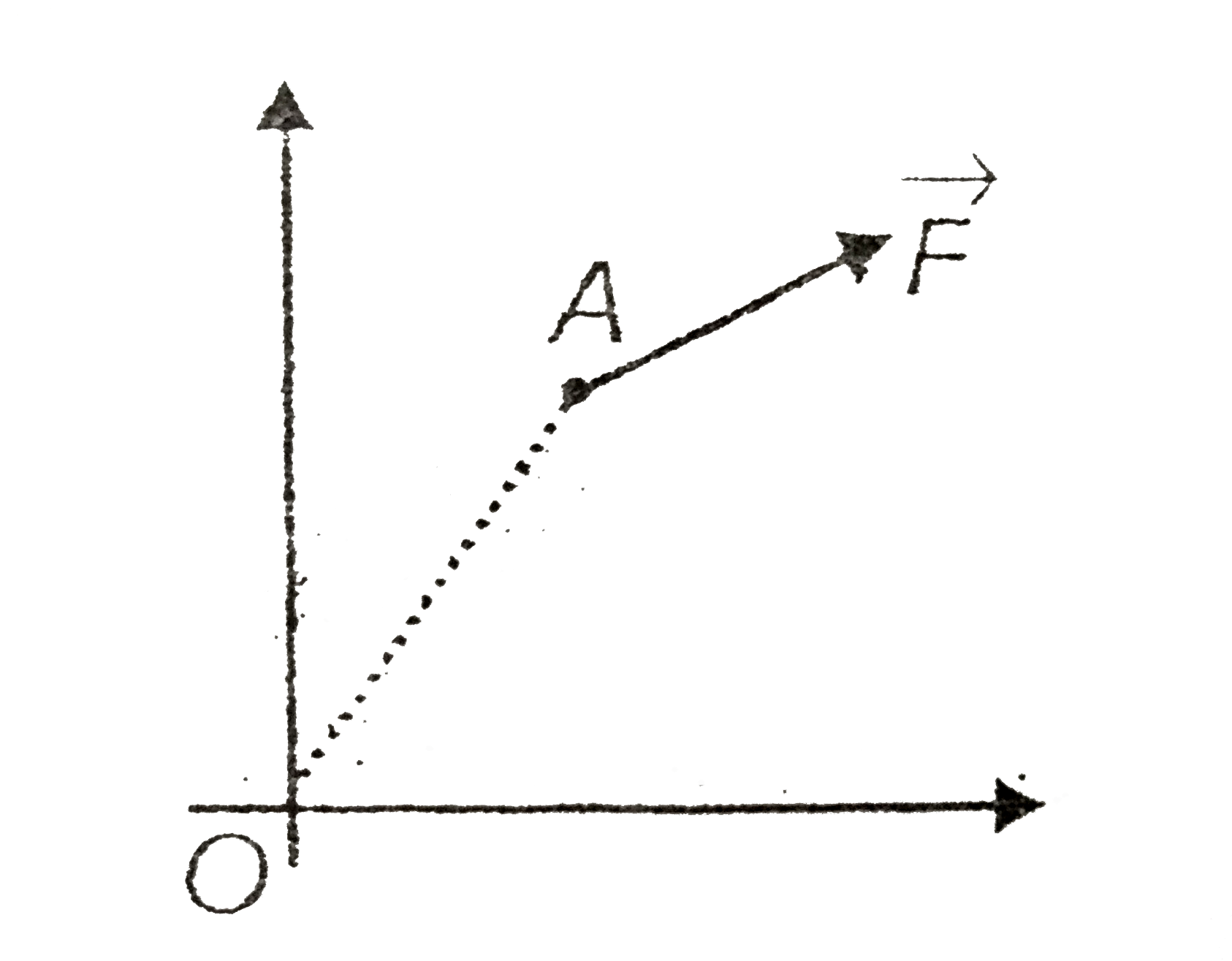A force F=(2ˆi+3ˆj−2ˆk)N is acting on a body at point (2m, 4m,−2m). Find torque of this force about origin.
To find the torque of the force F=(2^i+3^j−2^k)N acting at the point (2m,4m,−2m) about the origin, we can follow these steps:
Step 1: Write the Force and Position Vector
The force vector F is given as:
F=2^i+3^j−2^kN
The position vector r of the point where the force is applied is:
r=2^i+4^j−2^km
Step 2: Use the Torque Formula
The torque τ about the origin is given by the cross product of the position vector r and the force vector F:
τ=r×F
Step 3: Set Up the Determinant
To calculate the cross product, we can set it up using a determinant:
τ=∣∣
∣
∣∣^i^j^k24−223−2∣∣
∣
∣∣
Step 4: Calculate the Determinant
Now, we will calculate the determinant:
τ=^i∣∣∣4−23−2∣∣∣−^j∣∣∣2−22−2∣∣∣+^k∣∣∣2423∣∣∣
Calculating each of these 2x2 determinants:
1. For ^i:
∣∣∣4−23−2∣∣∣=(4)(−2)−(3)(−2)=−8+6=−2
2. For ^j:
∣∣∣2−22−2∣∣∣=(2)(−2)−(2)(−2)=−4+4=0
3. For ^k:
∣∣∣2423∣∣∣=(2)(3)−(2)(4)=6−8=−2
Putting it all together:
τ=−2^i−0^j−2^k=−2^i−2^k
Step 5: Write the Final Answer
Thus, the torque of the given force about the origin is:
τ=−2^i−2^kN m
The force vector F is given as:
F=2^i+3^j−2^kN
The position vector r of the point where the force is applied is:
r=2^i+4^j−2^km
The torque τ about the origin is given by the cross product of the position vector r and the force vector F:
τ=r×F
To calculate the cross product, we can set it up using a determinant:
τ=∣∣
∣
∣∣^i^j^k24−223−2∣∣
∣
∣∣
Now, we will calculate the determinant:
τ=^i∣∣∣4−23−2∣∣∣−^j∣∣∣2−22−2∣∣∣+^k∣∣∣2423∣∣∣
1. For ^i:
∣∣∣4−23−2∣∣∣=(4)(−2)−(3)(−2)=−8+6=−2
∣∣∣2−22−2∣∣∣=(2)(−2)−(2)(−2)=−4+4=0
∣∣∣2423∣∣∣=(2)(3)−(2)(4)=6−8=−2
τ=−2^i−0^j−2^k=−2^i−2^k
Thus, the torque of the given force about the origin is:
τ=−2^i−2^kN m
Topper's Solved these Questions
- ROTATIONAL MECHANICSBOOK - DC PANDEY ENGLISHCHAPTER - ROTATIONAL MECHANICSEXERCISE - Exercise 12.4
11 Videos
- ROTATIONAL MECHANICSBOOK - DC PANDEY ENGLISHCHAPTER - ROTATIONAL MECHANICSEXERCISE - Exercise 12.5
7 Videos
- ROTATIONAL MECHANICSBOOK - DC PANDEY ENGLISHCHAPTER - ROTATIONAL MECHANICSEXERCISE - Exercise 12.2
4 Videos
- ROTATIONBOOK - DC PANDEY ENGLISHCHAPTER - ROTATIONEXERCISE - (C) Chapter Exercises
39 Videos
- ROTATIONAL MOTIONBOOK - DC PANDEY ENGLISHCHAPTER - ROTATIONAL MOTIONEXERCISE - Integer Type Questions
17 Videos
Similar Questions
A force F=(2ˆi+3ˆj+4ˆk)N is acting at point P(2m,−3m,6m) find torque of this force about a point O whose position vector is
(2ˆi−5ˆj+3ˆk) m.
View SolutionA force →F=(ˆi+ˆj−ˆk)N acts at a point P(3 m, 6 m, 9 m). The torque exerted by this force about a point Q(2 m, 7 m, 8 m) is
View SolutionA force (ˆi−2ˆj+3ˆk) acts on a particle lying at origin. What is the torque acting on the particle about origin?
View SolutionA force of →F=2xˆi+2ˆj+3z2ˆkN is acting on a particle. Find the work done by this force in displacing the body from (1,2,3)m to (3,6,1)m.
View SolutionA force →F=(3ˆi+4ˆj)N is acting on a point mass m=(12)kg at a point A(2m,2m). Find the angular acceleration of the line OA at this instant.

View SolutionA force→F=4ˆi−5ˆj+3ˆkN is acting on a point →r1=2ˆi+4ˆj+3ˆkm. The torque acting about a point→r2=4ˆi−3ˆkm is
View SolutionThree forces ˆi+2ˆj−3ˆk,2ˆi+3ˆj+4ˆkandˆi−ˆj+ˆk acting on a particle at the point (0,1,2) the magnitude of the moment of the forces about the point (1,-2,0) is
View SolutionA force F=2ˆi+3ˆj−ˆk acts at a point (2,-3,1). Then magnitude of torque about point (0,0,2) will be
View SolutionA force (2ˆi+3ˆj−ˆk) newtons acts on a particle having position vector (ˆi−ˆj+2ˆk) . Find the torque of the force about origin.
View SolutionA force (ˆi−2ˆj+3ˆk) acts on a particle lying at origin. What is the torque acting on the particle about the origin.
View Solution
